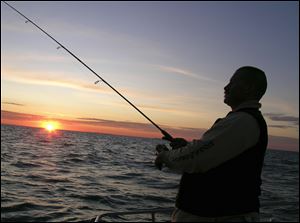
Great Lakes watershed bill draws concern
Opponents worry too much will be taken from tributaries
4/13/2012
Lake Erie fishing captains fear if too much water is withdrawn from Lake Erie's tributaries, at a pace that is quicker than it can be replenished, algal blooms that already have hurt the industry will increase.
COLUMBUS -- A proposal to regulate water withdrawals from the Lake Erie watershed faces opposition from environmental and sportsmen groups who argue it would inadequately protect inland rivers and streams teeming with life.
Gov. John Kasich last year vetoed Ohio lawmakers' first attempt at writing between the lines of the Great Lakes-St. Lawrence River Basin Water Resources Compact approved by eight states and Congress. That business-backed bill drew criticism from other states, two of Mr. Kasich's gubernatorial predecessors, and environmental groups, in part, because it would have set the most lenient thresholds for water withdrawals of any of the Great Lakes states.
The new bill roughly halves the proposed thresholds before a power plant, steel mill, manufacturer, farm, golf course, amusement park, or other user may withdraw water before requiring a state permit. This time around, it is the bill's treatment of tributaries that is fueling opposition, not the more competitive overall withdrawal numbers.
Paul Pacholski, vice president of Lake Erie Charter Boat Captains, said he fears the number of captains on the lake could drop from 750 last year to 700 this season. He attributes at least part of that to worsening algal blooms that could be exacerbated by reduced flow from tributaries.
"Most people who come off the boats rebook for the following year," he said. "A lot of people in August through October looked at the water and said, 'We'll call you about next year,' and the phones aren't ringing."
The National Wildlife Federation, Izaak Walton League, and the boat captains argued that the bill's definition of "source watershed" differs from that in the multistate compact, placing too much emphasis when it comes to assuming withdrawal impacts and not on the inland tributaries that replenish it.
"The tributaries for Lake Erie, in particular, provide certain critical habitat for a number of species," said Rick Graham, Ohio division president of the Izaak Walton League. "Steelhead, walleye, and smallmouth bass are all important issues to Lake Erie and also to the people who fish for them."
They voiced concern that users could withdraw water from inland lakes, streams, and rivers at a faster rate than it can be replaced, particularly during drier summer months.
But Linda Woggon, executive vice president for the Ohio Chamber of Commerce, said the chamber believes the bill's definition of "source watershed" is in line with the compact.
"More importantly, what's in this bill for high-quality streams is more stringent than in any other state in the basin," she said. "We want to protect Lake Erie. It's a valuable resource from both an economic and recreational perspective.
"This bill is protective of the lake and all its tributaries and watershed. We think [the prior bill] was as well," Ms. Woggon said.
House Bill 473 is sponsored by Rep. Lynn Wachtmann (R., Napoleon) and backed by such groups as the Ohio, Toledo, and Cleveland chambers of commerce; large farms; and the oil, chemical, soft drink, and mining industries.
"The governor feels very strongly about protecting Lake Erie as a resource," Kasich spokesman Connie Wehrkamp said. "While we continue to work with the sponsor on a few issues, we feel currently the bill is a dramatic improvement over what saw last summer."
The bill would allow users to consume up to 2.5 million gallons of water a day directly from the lake without having to get a permit. They could take 1 million gallons a day from groundwater, rivers, streams, and other inland sources within the watershed and 100,000 gallons from streams determined to be of high quality.
The daily use levels would be averaged over a 90-day period, in line with what Indiana and Pennsylvania have adopted. Other Great Lakes states average over shorter periods of time.
While generally supporting the bill, the Kasich administration has asked the House Agriculture and Natural Resources Committee to remove the 90-day averaging language for high-quality streams for fear it could leave them vulnerable in times of low flow.
Contact Jim Provance at: jprovance@theblade.com or 614-221-0496.